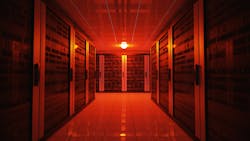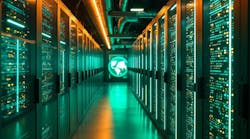Lessons for Data Centers in Honor of Fire Prevention Week’s 100th Anniversary
Innovations surrounding generative AI have driven the costs of data center buildouts skyward. According to 2025 market research, capital expenditures on global data centers largely tied to AI training infrastructure rose 51 percent in 2024, reaching $455 billion. This figure is projected to jump another 30 percent by end of 2025.
Unfortunately, risk mitigation standards have not kept pace with the escalating cost of data center assets. Fire protection, in particular, often remains an afterthought, with many facilities incorporating conventional sprinklers alone, meeting the minimal requirements set by local fire codes. The large-size water droplets generated by such systems destroy all electronics including the high-cost and difficult-to-replace AI components, resulting in catastrophic asset damage in the event of fire. Additional costs incurred as part of fire-related clean up and remediation, downtime and disruption, and perception issues add to the exorbitant risk.
It no longer makes sense for data centers, regardless of size, to continue using such systems by themselves. As their power needs escalate with demand for AI, the intense energy loads create an exponentially higher fire risk. This year alone, there have been reported fire incidents at such facilities as: a data center leased by a prominent social media platform; data centers in South Korea and Brazil; a data center construction site in Indiana; and multiple fires within mere weeks at a data center technology park in Virginia, to name a few.
In recognition of the centennial anniversary of National Fire Prevention Week (October 5-11), data center professionals—consultants, operators and investors—should take a lesson from the campaigns for residential fire prevention that have successfully driven safety awareness and risk mitigation since 1925.
As data center professionals invest in the protection and integrity of data center buildings, and surrounding structures within their communities that could be impacted by fire, they should simultaneously consider the protection of the costly revenue-producing assets inside their facilities. Traditional, heat-activated sprinkler systems were never designed with this goal in mind. Rather, they’re intended for other critical purposes: fire control, confinement and preservation of safety and life.
Fortunately, clean agent systems have demonstrated the ability to fill this important gap by providing an enhanced layer of protection when installed alongside mandatory sprinklers. Available for decades and referenced in the official standards published by the National Fire Protection Association (NFPA), they have become increasingly relevant specifically because they detect fires in the incipient or very early stage of smoke formation and extinguish without leaving any residue on data center equipment.
Compare these systems to traditional heat-activated sprinklers, which require heat from a burning object to reach the ceiling and be at sufficient temperature to operate and release the sprinkler bulb—a process that doesn’t happen instantly and could take several minutes while expensive assets are destroyed. Alternatively, the combination of very early warning detection systems, as per NFPA 72 standard, and clean agent systems, as per the NFPA 2001 standard, rapidly detect and reach extinguishing concentrations within mere seconds of activation.
To illustrate how, fires are caused by a combination of fuel, oxygen and heat—often referred to as the “fire triangle.” Clean chemical agents absorb heat from the surface of the burning material and effectively lower its temperature below the ignition point, thereby disrupting the fire triangle and suppressing the fire without harming equipment or personnel in the protected room. These chemicals are non-toxic when used in compliance with NFPA Standard 2001. They do not impair breathing or obscure vision in an emergency, providing an added measure of safety for personnel.
As an alternative, data centers can install clean agent systems that utilize inert gases instead of clean agent chemicals. These systems work by lowering the oxygen content in the room to a level where the process of combustion is no longer supported, which means that the fire won’t continue to burn. They provide three dimensional fire protection to the entire space, ensuring it reaches everywhere in the data center, effectively seeking the fire to extinguish. The gases they use are environmentally responsible, having an ozone depletion potential (ODP) of zero and a global warming potential (GWP) of zero.
Because clean fire agents do not leave messy residue, they cause zero damage to costly data center equipment. Once fire suppression is complete, building ventilation systems easily remove them.
Adding to savvy data center professionals’ understanding that clean agent systems are now vital, those involved in the building and operating of mega “hyperscale” data centers are increasingly becoming adopters. Once confident that the existence of parallel “mirror” sites in other geographies would offer sufficient risk mitigation by eliminating issues surrounding downtime and disruption, these behemoths have begun adding clean agent systems to augment necessary sprinklers to protect the value of AI components.
Just as National Fire Prevention Week has kept up with evolving risks, modifying the recommendations it provides, data center professionals should similarly adapt, looking beyond the sprinkler systems, pre-action layouts and hybrid solutions dictated by industry standards and local fire codes. They would be wise to consider the addition of clean agent systems, an investment that makes all the difference in the event of fire. Please consult a qualified fire suppression expert for more information.
About the Author

Jeff De Hart
Jeff De Hart is a Director, Vertical Development at KiddeFenwal. Connect with Jeff on LinkedIn.
KiddeFenwal is the global leader in the fire suppression and safety controls industry with solutions tailored specifically for data centers.

Mark Mushrow
Mark Mushrow is a Director, Vertical Development at KiddeFenwal. Connect with Mark on LinkedIn.
KiddeFenwal is the global leader in the fire suppression and safety controls industry with solutions tailored specifically for data centers.



